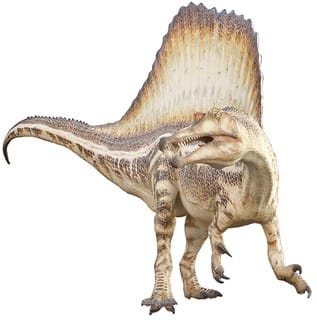What Did the Spinosaurus Really Look Like? New Evidence Reshapes this Dinosaur Icon

The Spinosaurus, one of the most iconic dinosaurs, rose to fame after starring in Jurassic Park 3, where it famously bested a T. rex. Now with its return in the upcoming Jurassic World: Rebirth, the Spinosaurus looks drastically different. This begs the question: What did the Spinosaurus look like?
To answer this, we will look at recent research from the paper “Tail-propelled aquatic locomotion in a theropod dinosaur” [1], which presents strong evidence that Spinosaurus wasn’t a land runner like T. rex but a specialised swimmer.
Old View vs New Evidence
· Old view: In the 1990s, researchers believed Spinosaurus hunted along riverbanks, using its long snout and arms to scoop up fish while walking on its two legs [1].
· New Evidence: A nearly complete Spinosaurus tail found in Morocco changed everything [1]. Rather than a slender, stiff tail, like other large predatory dinosaurs, it had a tall, flexible tail shaped more like a paddle or fin, perfect for moving side to side in the water and, thus, perfect for swimming [1].


Fig. 1. Comparison of what researchers thought Spinosaurus looked like, to how the new evidence suggests they looked. Image on the left “202005 Spinosaurus aegyptiacus.png”, By DataBase Center for Life Science (DBCLS). It is essential to note that these illustrations may vary slightly depending on the artist and their interpretation of the data.
Why the New Tail Matters
· Robotic tests: Scientists tested how this tail would move through water using a robotic model [1]. They found that the Spinosaurus tail generated over eight times more thrust compared to the T-rex, thus making it much more efficient for swimming [1].
· Stability: The paddle-shaped tail would also have kept Spinosaurus from rolling over in swift water currents while swimming [1]. This would have been vital for ambushing fish in dangerous rivers.
This evidence suggests that Spinosaurus's tail is more similar to what we see in Jurassic World: Rebirth compared to the apex land predator in Jurassic Park 3.
Even More Aquatic Adaptations
The tail isn't the only clue. Spinosaurus had a whole suite of adaptations for aquatic life:
- Shorter hind limbs and broad feet, possibly for paddling or walking underwater [1].
- Densely packed bones, which helped with buoyancy control and helped it stay submerged [1].
- Nostrils set far back on its head allowed it to breathe and “feel” prey while most of its head stayed underwater [1].
- Sensors on its snout, similar to those in crocodiles, detect movement in water [1]. Thus, it suggested that it either put its snout in the water while standing on the edge or swim and float like a crocodile.
· Conical, interlocking teeth: Perfect for gripping slippery fish [1].

An Aquatic Creature
These features suggest Spinosaurus wasn’t just wading in shallow water; it was actively swimming and hunting underwater, much like modern crocodiles or newts. Its massive, sail-like tail helped propel it forward with powerful side-to-side motions, making it the first known dinosaur with a tail specifically adapted for swimming [1]. It's possible it chased fish like a giant croc, using sleek bursts of speed rather than lying in wait on shore.
Spino vs T. rex: The Real Winner!!
But the question the people want answered. Who would win? The Spinosaurus or the T. rex? Well, in reality, this wouldn’t be possible, because the Spinosaurus died out 10 million years before T. rex came along. But if they were to fight, the T. rex’s bone-crushing jaws and muscular legs would win easily on land; however, if the Spinosaurus could get the T. rex in the water, it would have home-river advantage and turn the tide.
However, for now, the only way we will ever get to experience this hypothetical scenario is through the movies of the Jurassic Park series.
The Reality of a Real Spinosaurus
While Jurassic Park 3 gave us a terrifying land predator, real science is now painting a different and possibly more fascinating picture: a 50-foot semi-aquatic hunter, gliding through ancient rivers with a tail made for speed and power, which is what we are seeing now in Jurassic World: Rebirth.
Want to Learn More?
If you would like to know more about dinosaurs or any other topic, subscribe or become a member to join the community and stay tuned for more content.
References
Reference paper “Tail-propelled aquatic locomotion in a theropod dinosaur”
